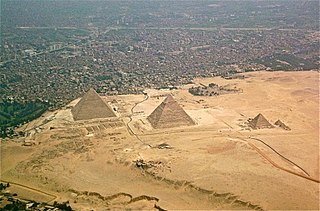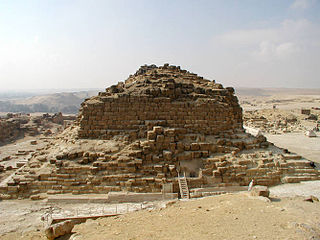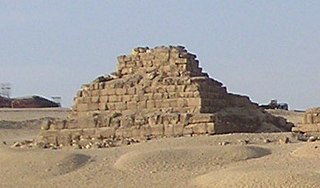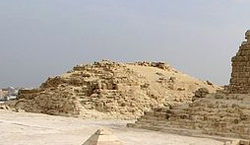
The Great Pyramid of Giza is the largest Egyptian pyramid. It served as the tomb of pharaoh Khufu, who ruled during the Fourth Dynasty of the Old Kingdom. Built c. 2600 BC, over a period of about 26 years, the pyramid is the oldest of the Seven Wonders of the Ancient World, and the only wonder that has remained largely intact. It is the most famous monument of the Giza pyramid complex, which is part of the UNESCO World Heritage Site "Memphis and its Necropolis". It is situated at the northeastern end of the line of the three main pyramids at Giza.

The Great Sphinx of Giza is a limestone statue of a reclining sphinx, a mythical creature with the head of a human and the body of a lion. Facing directly from west to east, it stands on the Giza Plateau on the west bank of the Nile in Giza, Egypt. The face of the Sphinx appears to represent the pharaoh Khafre. The original shape of the Sphinx was cut from bedrock, and has since been restored with layers of limestone blocks. It measures 73 m (240 ft) long from paw to tail, 20 m (66 ft) high from the base to the top of the head and 19 m (62 ft) wide at its rear haunches.

The Egyptian pyramids are ancient masonry structures located in Egypt. Sources cite at least 118 identified "Egyptian" pyramids. Approximately 80 pyramids were built within the Kingdom of Kush, now located in the modern country of Sudan. Of those located in modern Egypt, most were built as tombs for the country's pharaohs and their consorts during the Old and Middle Kingdom periods.

The pyramid of Khafre or of Chephren is the middle of the three Ancient Egyptian Pyramids of Giza, the second tallest and second largest of the group. It is the only pyramid out of the three that still has cladding at the top. It is the tomb of the Fourth-Dynasty pharaoh Khafre (Chefren), who ruled c. 2558−2532 BC.

The pyramid of Menkaure is the smallest of the three main pyramids of the Giza pyramid complex, located on the Giza Plateau in the southwestern outskirts of Cairo, Egypt. It is thought to have been built to serve as the tomb of the Fourth Dynasty Pharaoh Menkaure.

The Giza pyramid complex in Egypt is home to the Great Pyramid, the Pyramid of Khafre, and the Pyramid of Menkaure, along with their associated pyramid complexes and the Great Sphinx. All were built during the Fourth Dynasty of the Old Kingdom of ancient Egypt, between c. 2600 – c. 2500 BC. The site also includes several temples, cemeteries, and the remains of a workers' village.

Mark Lehner is an American archaeologist with more than 30 years of experience excavating in Egypt. He is the director of Ancient Egypt Research Associates (AERA) and has appeared in numerous television documentaries.

The Giza Plateau is a limestone plateau in Giza, Egypt, the site of the Fourth Dynasty Giza pyramid complex, which includes the pyramids of Khufu, Khafre and Menkaure, the Great Sphinx, several cemeteries, a workers' village and an industrial complex. It forms the northernmost part of the 16,000 ha Pyramid Fields in the Western Desert edge of the Nile Valley that are part of the UNESCO World Heritage Site, Memphis and its Necropolis.

The Layer Pyramid is a ruined step pyramid dating to the 3rd Dynasty of Egypt and located in the necropolis of Zawyet El Aryan. Its ownership is uncertain and may be attributable to pharaoh Khaba. The pyramid architecture, however, is very similar to that of the Buried Pyramid of king Sekhemkhet and for this reason is firmly datable to the 3rd Dynasty.

Egyptian pyramid construction techniques are the controversial subject of many hypotheses. These techniques seem to have developed over time; later pyramids were not constructed in the same way as earlier ones. Most of the construction hypotheses are based on the belief that huge stones were carved from quarries with copper chisels, and these blocks were then dragged and lifted into position. Disagreements chiefly concern the methods used to move and place the stones.

The Khufu ship is an intact full-size solar barque from ancient Egypt. It was sealed into a pit alongside the Great Pyramid of pharaoh Khufu around 2500 BC, during the Fourth Dynasty of the ancient Egyptian Old Kingdom. Like other buried Ancient Egyptian ships, it was part of the extensive grave goods intended for use in the afterlife. The Khufu ship is one of the oldest, largest, best preserved vessels from antiquity. It is 43.4 metres (142 ft) long, 5.9 metres (19 ft) wide, and 1.78 meters deep, and is the world's oldest intact ship. It has been described as "a masterpiece of woodcraft" that could sail today if put into a lake or a river.
Meritites I was an ancient Egyptian queen of the 4th Dynasty. Her name means "Beloved of her Father". Several of her titles are known from a stela found at Giza. She was buried in the middle Queen’s Pyramid in Giza.

Henutsen is the name of an ancient Egyptian queen consort who lived during the 4th dynasty of the Old Kingdom Period. She was the second or third wife of pharaoh Khufu and most possibly buried at Giza.

G1-b is one of the subsidiary pyramids of the Giza East Field of the Giza Necropolis immediately to the eastern side of the Great Pyramid of Giza, built during the Fourth Dynasty of Egypt. It is the central of the three pyramids of the queens, located ten meters south of the Pyramid G1-a. It has a base of 50 meters and had an original height of 30 meters. Egyptologists Mark Lehner and Rainer Stadelmann attribute it to the queen Meritites I. Zahi Hawass, however, attributes it to Queen Noubet, who gave birth to Djedefre. It is one of the queen pyramids near Pyramid Khufu along with the other two queen pyramids Pyramid G1-a and Pyramid G1-c, along with another smaller pyramid called Pyramid G1-d.

G1-c is one of the subsidiary pyramids of the Giza East Field of the Giza Necropolis immediately to the eastern side of the Great Pyramid of Giza, built during the Fourth Dynasty of Egypt. It is the southern of the three pyramids of the queens and is the one of Queen Henutsen. It is 46.25 metres wide and had a height of 29.60 metres. A niche, four inches deep was dug in the south wall of the burial chamber. Pyramid G1-c was originally not a part of Khufu's pyramid complex, as its southern side is aligned not with the side of the Great Pyramid, but with Khufukhaf I's mastaba tomb nearby. Pyramid G1-c was at some point thought to possibly be a satellite pyramid, because it did not come with a boat pit like pyramids G1-a and G1-b. It was later determined to be an unfinished pyramid which was constructed in a hurry. Henutsen is thought to have been buried in the tomb. Dr. Rainer Stadelmann believes Khufukhaf is the same person as Khafra and the pyramid was built by him for his mother, but this identification is doubtful.

Pyramid G1-d is a satellite pyramid within the Khufu pyramid complex on the Giza plateau.

In Egypt, the Western Desert is an area of the Sahara that lies west of the river Nile, up to the Libyan border, and south from the Mediterranean Sea to the border with Sudan. It is named in contrast to the Eastern Desert which extends east from the Nile to the Red Sea. The Western Desert is mostly rocky desert, though an area of sandy desert, known as the Great Sand Sea, lies to the west against the Libyan border. The desert covers an area of 680,650 km2 (262,800 sq mi) which is two-thirds of the land area of the country. Its highest elevation is 1,000 m (3,300 ft) in the Gilf Kebir plateau to the far south-west of the country, on the Egypt-Sudan-Libya border. The Western Desert is barren and uninhabited save for a chain of oases which extend in an arc from Siwa, in the north-west, to Kharga in the south. It has been the scene of conflict in modern times, particularly during the Second World War.

G3-c is one of the three pyramid companions Pyramid of Menkaure. It is located on the south side of the Menkaure pyramid in the Giza Necropolis. It is the westernmost of the three pyramids of the queens.

The pyramid of Khentkaus I or step tomb of Khentkaus I is a Fourth Dynasty two-stepped tomb built for the Queen Mother Khentkaus I in Giza. The tomb, built in two phases coinciding with its two steps, was originally known as the fourth pyramid of Giza. In the first phase, a nearly square block of bedrock, around which the stone had been quarried for the Giza pyramids, was utilised to construct her tomb and encased with fine white Tura limestone. In the second phase, most likely in the Fifth Dynasty, her tomb was enlarged with a large limestone structure built on top of the bedrock block. The Egyptologist Miroslav Verner suggests that this may have been intended to convert her tomb into a pyramid, but was abandoned as a result of stability concerns. South-west of the tomb was a long boat pit, which housed the Night boat of Re. A companion day boat has not been found. A chapel was built into the tomb superstructure, with a large granite entrance bearing the queen's name and titles. One of her titles was of particular interest because it had not been known of prior to its discovery at her tomb.

G3-a is one of the three pyramid companions of the Pyramid of Menkaure. It is located on the south side of the Menkaure pyramid in the Giza Necropolis. It is the easternmost of the three pyramids of the queens. The pyramid was built during the Fourth Dynasty of Egypt, presumably for one of the wives of Menkaure. Egyptologist George Andrew Reisner was "confident" that the structure housed Khamerernebty II, but this is far from certain.



















